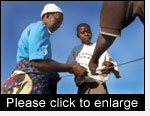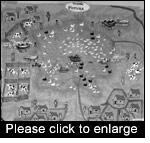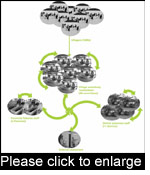InfoResources
News No 3 / 05 (June 2005)
Special feature
> HIV/AIDS threatens rural development.
What can be done?
Of current interest
Policy
> Monetarising nature
> Stabilising the resource basis for food
security
> Trade policy
for poverty reduction
> Phased approaches to forest certification
Implementation
> Promoting local innovation
> Agrobiodiversity – gender – local
knowledge
> Complexity and uncertainty call for adaptive
learning
> What are the challenges of natural
resource management for
least developed countries
(LDCs)?
Research
> Conflicts in forest regions
> New agenda for European agricultural research
for development
HIV/AIDS threatens rural development. What can be done?
 In southern Africa, as well as South East Asia, HIV/AIDS has been spreading
rapidly in recent years. The epidemic is increasingly moving from the
cities to rural areas, where the impact will become apparent only in
the coming years. However, it is clear now that there will be an acute
danger of the disease destroying any previous progress in poverty reduction.
In southern Africa, as well as South East Asia, HIV/AIDS has been spreading
rapidly in recent years. The epidemic is increasingly moving from the
cities to rural areas, where the impact will become apparent only in
the coming years. However, it is clear now that there will be an acute
danger of the disease destroying any previous progress in poverty reduction.
According to a paper of the Overseas Development Institute (ODI), the
impact of HIV/AIDS on agricultural production is only gradually becoming
apparent. In periods of intense labour the disease can cause a lack
of experienced agricultural workforce, as the sick can no longer work
and, in addition, need to be looked after by healthy people. Additional
expenses for the care of the sick, combined with less income due to
the lack of working hours, strain household budgets. As a result, some
households are forced to sell their means of agricultural production.
When a household head dies, the family often not only loses valuable
agricultural knowledge; in many cases, widows also lose land and possessions
to the family of the deceased. In addition, the epidemic can have impacts
on a wider regional scale, causing discontinuation of governmental services
such as agricultural extension, as well as ruptures in the agricultural
supply chain due to the decease of key persons.
These problems are not new. They arise as a result of other catastrophes
as well. However, the enormous dimensions of the HIV/AIDS epidemic make
the vulnerability of the poor to additional strains particularly visible.
As a reaction to the threat, the authors generally recommend that previous
and current efforts towards rural development be intensified. In addition,
they mention specific entry points: Shared financing and insurance systems
should be improved, and, where needed, cash transfers made in order
to prevent families from having to sell their means of agricultural
production. Land and ownership rights of women and orphans should be
strengthened. The use of labour-saving technologies in both agricultural
production and housework can help to cushion the impact of loss of working
hours. Efforts in education, promotion of farmers’ associations and
the dissemination of market information can strengthen agricultural
supply chains and reduce their dependency on individual persons. Finally,
there is a need for large-scale investment in education in order to
compensate for lost agricultural knowledge.
FAO and the World Food Programme are tackling this last issue in a joint
initiative: they have built agricultural schools for orphans in Mozambique.
In these so-called ”Junior Farmer Field and Life Schools”, children
learn the basic skills needed to produce food and generate agricultural
income. These agricultural subject matters are combined with ”survival
assistance”, where the children are taught life skills such as self-awareness
and self-confidence, human rights, and AIDS prevention. The project
has been highly successful in Mozambique and will now be expanded to
Kenya, Namibia, Zimbabwe, and Swaziland.
The impact of diseases and epidemics on agricultural production have
never been studied in detail, and possible solutions are only beginning
to be discussed. A symposium entitled ”Poor health, food insecurity,
and poverty – How to break a vicious circle?” will be held on 13 October
2005 in Berne, Switzerland. This event is intended to strengthen networking
between the health and agriculture sectors, and to contribute to finding
useful strategies for the rural populations in areas affected by diseases.
Sources:
> Responding to HIV/AIDS in agriculture and related activities.
Rachel Slater and Steve Wiggins. ODI, Natural Resource Perspectives.
No 98, March 2005. 6p. www.odi.org.uk/nrp/98.pdf
> Agricultural skills necessary for AIDS orphans. Field schools
pass on
livelihood knowledge. FAO News Story. Rome, 1 December 2004.
www.fao.org/newsroom/en/news/2004/51715/
> ”Poor health, food insecurity and poverty – How to break a vicious
circle?” Symposium on the occasion of World Food Day. 13 October 2005,
Berne, Switzerland. www.infoagrar.ch/symposium2005/index.htm

Of current
interest: Policy
Monetarising nature
Talking about water or biodiversity means talking politics. Both are
interlinked with trade, agricultural, social, and, above all, human
rights policies. Friends of the Earth International has published a
report on the impacts of the privatisation of natural goods, a phenomenon
that is increasingly favoured by policy-makers. Nature for sale is a
document of global significance, describing more than 35 examples from
around the world. In doing so, the report illustrates the experience
that the poor make with profit-oriented transnational companies.
As water will become tomorrow’s gold, companies have taken interest
in the water of the ”Cuenca del Plata”, one of the Earth’s most significant
catchments, holding more than 30 percent of the global freshwater reserve.
New laws allow private entrepreneurs to penetrate into the water sector,
previously publicly administered. The region’s governments additionally
foster this development with their project of transforming 1940 kilometres
of the Paraguay-Parana river system into a gigantic industrial waterway.
In other regions of the world, nature parks are ”disneyfied”, and the
wealthy industrial countries have built up a lucrative trade with carbon
sequestration quota. This report makes very clear that the monetarisation
of nature has lifethreatening consequences for the world’s 1.2 billion
poor.
Source: Friends of the Earth International,
Amsterdam www.foei.org/publications/pdfs/privatization.pdf
Stabilising the resource basis for food security
Food production is no longer continually increasing. In certain important
food producing countries irrigated agricultural land is actually diminishing.
Fishery production, after a long period of growth, is now on the decrease.
Newest research results show that a global temperature rise by 1°C
could reduce cereal production by up to 10%. Water tables are falling
at alarming rates.
China’s cereal production has been decreasing since 2000, drastically
reducing national reserves. If this trend continues, China’s dependency
on imports will grow, leading to a global rise of commodity prices.
This can give rise to increased unrest and conflicts particularly in
developing countries. These developments pose a challenge to policy-makers
not only in the agriculture sector, but also in the energy, economy,
and education sectors. Future food security depends on whether we will
succeed in stabilising the 4 agricultural key resources: cereal cropland,
water, pastures, and the global climate.
Another study develops four scenarios to illustrate the fact that a
reduction of the number of people suffering food insecurity by 2015
and beyond can only be achieved if investments in rural development,
health, education and agricultural research are increased.
Sources:
> Outgrowing the earth: the food security challenge in an age
of
falling water tables and rising temperatures. Lester R. Brown.
Earth Policy Institute. W.W. Norton&Company, London New York. 2004.
233 p. www.earth-policy.org/Books/Out/Contents.htm
> New Risks and Opportunities for Food Security. Scenario Analyses
for
2015 and 2050. J. von Braun et al. 2020 Discussion Paper No 39.
International Food Policy Research Institute. Washington. 2005. 32 p.
www.ifpri.org/2020/dp/dp39/2020dp39.pdf

Trade policy for poverty reduction
Many industrialised countries are supporting their agricultural exports
with massive subsidies, while developing countries are pressured into continually
reducing their import tariffs on farm products. The resulting flow of
cheap food to developing countries, although welcomed by urban consumers,
leads to the ruin of rural farmers.
With a view to the upcoming WTO Ministerial Conference planned to take
place in December in Hong Kong, Oxfam demands that industrialised countries
cancel all export subsidies. At the same time, developing countries
should be allowed more flexibility, enabling them to tailor their agricultural
trade policies to the needs of rural development and poverty reduction.
In concrete terms, they should be allowed to reduce their tariffs more
conservatively, and, with regard to certain products that are vital
to food security, not to reduce them at all. In fact, specific mechanisms
should enable them to react to sudden fluctuations in quantities and
prices, as well as to subsidised exports from industrialised countries,
by actually raising the tariffs. Furthermore, Oxfam demands that the
regulation of international agricultural trade remain fully in the hands
of the WTO. Oxfam explicitly rejects regional trade agreements, as well
as IMF and World Bank payments tied to trade policy conditions. Finally,
Oxfam calls on the developing countries to raise their investments into
sustainable agriculture.
Source: Kicking down the door. How upcoming
WTO talks threaten
farmers in poor countries. Oxfam Briefing Paper 72. April 2005. 69 p.
www.oxfam.org.uk/what_we_do/issues/trade/downloads/bp72_rice.pdf
Phased approaches to forest certification
The issue of phased certification was discussed at a workshop of the
International Tropical Timber Organization (ITTO) held recently in Berne,
Switzerland, as a means of addressing the problem of tropical developing
countries lagging behind with timber certification. Phased approaches
facilitate access to forestry product markets before the certification
process is fully completed.
In January 2002, 109 million ha of forests were certified worldwide.
Only 8% of this area is located in developing countries. On the whole,
less than 3% of the world’s forest area is currently certified, meaning
that the impact of certification on forests is low, if not insignificant.
Workshop participants were mainly concerned with two issues, the first
being the promotion of tropical forest certification in view of the
current market variability, as well as stakeholder requirements related to legality
and sustainability, and the second being the implementation of phased
approaches to certification.
However, certification alone will neither save the world’s forests,
nor will it
solve the question of sustainable forest management. The link to governance
issues in the forestry sector is evident (illegal logging), and international
support will be needed. In this respect, the Swiss government could
take on an important part in promoting policy dialogue on forestry issues.
Information: www.itto.or.jp/live/PageDisplayHandler?pageId=223&id=969

Of current interest: Implementation
 Promoting local innovation
Promoting local innovation
The Centre for Development and Environment, in collaboration with partners
from Switzerland and from the South, has developed a new tool for promoting
local innovations. The tool consists of a moderated workshop that supports
a social learning process involving representatives of rural communities,
NGOs, technicians, and political communities. The process focuses on
interactive identification and validation of local innovations, as well
as the development of a plan for concerted promotion of the most promising
innovations.
Technical and, in particular, social and institutional local innovations
are essential for sustainable rural development. The innovative power
of rural communities becomes particularly important in contexts of constantly
changing social, economic, political and ecological conditions. This
new tool can help to integrate endogenous potentials more systematically
into planning and implementation of programmes and projects. By doing
so, it helps prevent a one-sided focus on external, mostly technical
innovations from competing with locally rooted innovation potentials.
The tool’s six work units are explained based on experiences from two
five-day workshops in Peru.
Source: AIL Apoyando Innovaciones
Locales: Un instrumento para el fortalecimiento de innovaciones locales
y la promoción del desarrollo rural
sostenible. Sabine Brüschweiler, Stephan Rist. 2005. CDE Centre
for
Development and Environment. Berne. 19p. www.cde.unibe.ch/Tools/AIL_Ts.asp
English version to be published soon.
Agrobiodiversity – gender – local
knowledge
75% of the genetic diversity in agricultural plants existing in 1900
has been lost. This is particularly due to the abandonment of highly
diverse local varieties and cultures and their replacement with genetically
uniform high-yield varieties. Today, agrobiodiversity is additionally
threatened by the globalisation of food systems, HIV/AIDS, and the increasing
feminisation of agriculture. Loss of agrobiodiversity also means a loss
of food security. The use and cultivation of agrobiodiversity are closely
linked with rural populations’ varied livelihood strategies based on
local knowledge and a gender-specific division of tasks. A new manual
shows ways of integrating these interlinkages into international policies,
agreements, and projects. Fact sheets provide thorough explanations
of the complex interrelations between agrobiodiversity, local knowledge,
and gender-specific aspects. Process sheets then suggest ways of exploring
these interrelations during shared learning processes with the affected
population in a local context.
Source: Building on Gender, Agrobiodiversity
and Local Knowledge: A Training Manual. Links, FAO. 2005. 88p.
www.fao.org/sd/linKS/documents_download/Manual.pdf

Complexity and uncertainty call for adaptive learning
 The
Laotian government encouraged the stocking of small water bodies with
hatchery produced fish in order to increase fishery production. However,
experiments showed that the expected results with regard to production
increase, distribution and institutional sustainability have not materialised.
Natural resource use is often based on incomplete knowledge of both
ecological and institutional interrelations. The
Laotian government encouraged the stocking of small water bodies with
hatchery produced fish in order to increase fishery production. However,
experiments showed that the expected results with regard to production
increase, distribution and institutional sustainability have not materialised.
Natural resource use is often based on incomplete knowledge of both
ecological and institutional interrelations.
The adaptive learning approach does not attempt to hide these uncertainties,
but rather tries to reduce them in a shared process involving the various
stakeholders, while at the same time enabling decisions concerning resource
use. Learning and resource use take place simultaneously. In this process,
information sharing and communication are of vital importance. The guidelines
offer practice-oriented advice on how to implement adaptive learning
in three steps: preparing, learning, and evaluating. Among other things,
the guidelines explain under which circumstances adaptive learning makes
sense, which skills and resources are needed to implement it, and what
kind of problems may be encountered during the process. The guidelines
were developed and tested in a fishery context in Laos.
Source: Adaptive learning: a practical
framework for the implementation
of adaptive co-management – lessons from selected experiences in
South and Southeast Asia. C.J. Garaway, and R.I. Arthur. MRAG
Ltd London. 2004. 44 p.
www.streaminitiative.org/Library/pdf/organizations/Adaptivelearning.pdf
What are the challenges of natural resource management for least
developed countries (LDCs)?
The publication ”Lands of the Poor”, part of the United Nations Capital
Development Fund mandate to reduce poverty in LDCs, centres on an analysis
of current thinking and debate on environmental issues and on the Millennium
Development Goals (MDGs). Its aim is to establish a policy framework
and pinpoint appropriate strategic options.
Both the social fabric and safety of poor populations are compromised
by the collapse of ecosystems. For local governments, productive resources
represent a source of legitimacy and economic potential. Consequently,
environmental protection and efforts to reinforce local democracy overlap,
sometimes resulting in conflict.
Local development programmes were involved in recent projects. Past
experience shows that, if this challenge is to be tackled successfully,
greater focus must be given to environmental governance, its planning,
its institutional, administrative and financial framework, as well as
the place of civil society in the process.
Finally, the author offers a rare but welcome critically argued look
at LDCs and their place in an environmental protection context, and
proposes a way to consider them at the local level.
Source: Lands of the Poor: Local Environmental
Governance
and the Decentralization of Natural Resources. Angelo Bonfiglioli. United
Nations Capital Development Fund (UNCDF), 2004. 162 p.
www.uncdf.org/english/local_development/documents_and_reports/
thematic_papers/lands/uncdf_lands.pdf

Of current
interest: Research
Conflicts in forest regions
Forest regions are the setting for many armed conflicts. Often difficult
to
access, they provide the perfect hiding place and cover for a wide range
of
illegal activities, sometimes involving corrupt armed forces (oil and
mineral
exploitation, forest extraction, drug trafficking). Forests can also
be the subject of a number of disputes on the exploitation of ever decreasing
forest resources between local populations, each fighting for their
own survival. A recent publication by the European Tropical Forest Research
Network (ETFRN) provides an update on the issue of ”forests and conflicts”.
They offer a range of case studies, examples of which include how to
protect nature in a war zone, the implications for forest management
and the local populations in the Congo, the roles of institutions in
Mozambique, the peace process in Colombia and the co-management of forests
in Ethiopia and in Nepal.
The report also presents a toolkit, which is aimed at closely linking
conflict management with development cooperation. Based on lessons already
learned, it proposes examples of key projects, a survey on the identification
of conflict sensitivities, and provides a list of relevant organisations
and specialists in the field.
Source: Forests and conflicts.
European Tropical Forest Research Network (ETFRN). News no. 43 – 44,
Winter 2004 – 2005. 140 p.
www.etfrn.org/etfrn/newsletter/news4344/index.html
Other organisations and publications in this field:
www.etfrn.org/etfrn/resource/frames/linkconflict.html
Toolkit available soon at: www.usaid.gov/our_work/
cross-cutting_programs/conflict/recent_events/
and at:
www.adelphi-research.de/
New agenda for European agricultural research for development
 At a conference of the European Forum on Agricultural Research for Development
(EFARD) in Zurich, Switzerland, participants drew up a new agenda for
a European contribution to agricultural research for development. They
also adopted a so-called ”Zurich Declaration”.
At a conference of the European Forum on Agricultural Research for Development
(EFARD) in Zurich, Switzerland, participants drew up a new agenda for
a European contribution to agricultural research for development. They
also adopted a so-called ”Zurich Declaration”.
EFARD regards itself as part of the Global Forum on Agricultural Research
and supports a holistic research approach that integrates aspects of
human health, sustainability, knowledge transfer, and education. The
members of the Forum intend to contribute directly to Millennium Development
Goals 1 (eradication of extreme poverty and hunger) and 7 (ensuring
of environmental sustainability), as well as indirectly to the remaining
MDGs.
EFARD plans to strengthen the involvement of the new EU member states,
and to promote collaboration in partnerships between South and North,
South and South, as well as with the research centres of the Consultative
Group on International Agricultural Research (CGIAR). In Europe, EFARD
wants to increase active exchange with other similar initiatives.
The Forum calls on the European Commission and the governments of the
EFARD member states to support agricultural research and thereby contribute
to making a significant step towards the Millennium Development Goals.
Source: EFARD 2005 – International Conference
on Agricultural Research
for Development: European Responses to Changing Global Needs, 27 – 29
April 2005, Swiss Federal Institute of Technology Zurich, Switzerland.
Issues Paper, including Zurich Declaration. 15p.
www.efard2005.org/proceedings.htm

|




